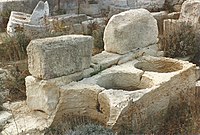San Pawl Milqi
San Pawl Milqi (also San Paolo Naufrago) in San Pawl il-Baħar is the largest Roman villa ever discovered in Malta . According to tradition, it belonged to Publius of Malta , the first bishop of the island to greet Paul of Tarsus in AD 60 after his shipwreck. However, there is no archaeological evidence to support this hypothesis. The only traces of Christian worship on the site can be dated to the 14th century.
The square was already used in prehistoric times. Some graves have been dated from the Maltese Bronze Age to the phases of Żebbuġ and Borġ-in-Nadur. The first building on the site was probably built in the Phoenician - Punic period and used for agriculture. Some buildings with a burial and a Punic inscription have survived from this phase.
In Roman times, the location of the place on the slopes of a fertile valley and the proximity to the port of Salina made the place an ideal place for the production of olive oil. The villa was enlarged and the original central courtyard was converted into a production area. The trapetum (a rotating mill that was used to separate the seeds from the olive fruits), anchor points and at least two presses, as well as a number of filter tanks for cleaning the oil, are visible.
Although the mansion is large enough to belong to a wealthy aristocrat, it does not contain any residential areas of particular importance. The four rooms were recognized as utility rooms and only decorated with painted plaster and ordinary cocciopesto floors. There is no evidence of mosaic floors like in Maltese houses of Rabat .
The area was probably reduced in size during the time of the Arab rule on Malta (870-1091 AD) and surrounded by a wall. The wall, the continuous water supply and the location suggest that the villa was used to control the nearby port of Is-Salina .
A church was built on one side of the site in the 14th century, but it was no longer used after about a century. In 1616 it was replaced by a church dedicated to St. Paul. The church that still exists today is one of the oldest testimonies connected with the tradition of the place.
Although the remains of the villa had been known for some time, the first scientific investigations did not begin until 1963 by the Italian archaeological mission in Malta, led by Sabatino Moscati. The villa is managed by Heritage Malta and is not accessible. However, it can be visited during the annual open house.
literature
- Maria Pia Rossignani: La ripresa delle indagini della Missione Archeologica Italiana a Malta. Nuovi dati dal santuario di Tas Silg e dalla villa di San Pawl Milqì. In: Atti della Pontificia Accademia Romana di Archeologia. LXXVIII, 2006, ISSN 1019-9500, pp. 129-146.
- Mario Buhagiar: The early Christian remains at Tas-Silġ and San Pawl Milqi, Malta. A consideration of the archaeological evidence. In: Melita Historica. 11 (4), 1996, pp. 1-41.
Web links
- San Pawl Milqi. (PDF) In: National Inventory of the Cultural Property of the Maltese Islands. Sovrintendenza tal-Patrimonju Kulturale, December 16, 2011, accessed on October 13, 2019 .
Coordinates: 35 ° 56 ′ 0.1 ″ N , 14 ° 24 ′ 41.8 ″ E


